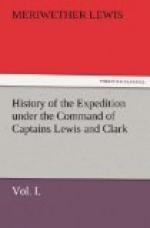Friday, 12. In consequence of the wind the canoes did not reach the lower camp till late in the afternoon, before which time captain Lewis sent all the men he could spare up the river to assist in building the boats, and the day was too far advanced to reload and send them up before morning. The mosquitoes are very troublesome, and they have a companion not less so, a large black gnat which does not sting, but attacks the eyes in swarms. The party with captain Clarke are employed on the canoes: in the course of the work serjeant Pryor dislocated his shoulder yesterday, but it was replaced immediately, and though painful does not threaten much injury. The hunters brought in three deer and two otter. This last animal has been numerous since the water has become sufficiently clear for them to take fish. The blue-crested fisher, or as it is sometimes called, the kingfisher, is an inhabitant of this part of the river; it is a bird rare on the Missouri: indeed we had not seen more than three or four of them from its entrance to Maria’s river, and even those did not seem to reside on the Missouri but on some of the clearer streams which empty into it, as they were seen near the mouths of those streams.
Saturday 13. The morning being fair and calm captain Lewis had all the remaining baggage embarked on board the six canoes, which sailed with two men in each for the upper camp. Then with a sick man and the Indian woman, he left the encampment, and crossing over the river went on by land to join captain Clarke. From the head of the Whitebear islands he proceeded in a southwest direction, at the distance of three miles, till he struck the Missouri, which he then followed till he reached the place where all the party were occupied in boat-building. On his way he passed a very large Indian lodge, which was probably designed as a great council-house, but it differs in its construction from all that we have seen lower down the Missouri or elsewhere. The form of it was a circle two hundred and sixteen feet in circumference at the base, and composed of sixteen large cottonwood poles about fifty feet long, and at their thicker ends, which touched the ground, about the size of a man’s body: they were distributed at equal distances, except that one was omitted to the east, probably for the entrance. From the circumference of this circle the poles converged towards the centre where they were united and secured by large withes of willow brush. There was no covering over this fabric, in the centre of which were the remains of a large fire, and round it the marks of about eighty leathern lodges. He also saw a number of turtledoves, and some pigeons, of which he shot one differing in no respect from the wild pigeon of the United States. The country exhibits its usual appearances, the timber confined to the river, the country on both sides as far as the eye can reach being entirely destitute of trees or brush. In the low ground in which we are building the canoes,




